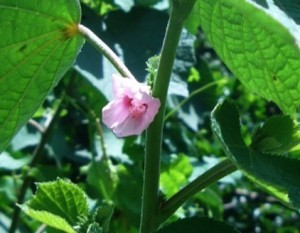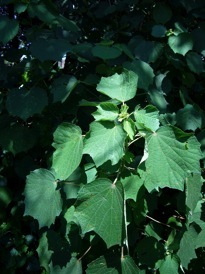Urena Lobata: Cash crop to noxious weed
Once it was an invited money-maker, now it is a hunted money spender: Caesar weed, cash crop to noxious weed.
We have often discussed what is a weed, and what is a noxious weed. Many “weeds” were food for previous generations, and some noxious weeds were valuable plants until technology moved on. Such is the story of the Caesar Weed.
Caesar Weed, Urena lobata, is in the mallow family and was imported to Florida for cordage a little prior to 1882, which makes sense; its cousin is cotton. Caesar weed is a good substitute for flax and jute and was at one time an important crop, still is in Brazil where it is called Armina Guaxima or Armania fiber. It’s also called Congo Jute. Now it‘s a “noxious weed” in Florida because it is not used anymore and spreads easily. While it grows happily river side it can grow on dry land with enough rain.
If you remember, the foraging phrase is all mallows are edible in some way, except the cotton (it’s oil is edible after processing.) The Caesar Weed is one of those mallows on the cusp of edible/not edible. As a food, Caesar weed is not high on the list. It is a “famine food” in Africa. When you eat it the main issue is not taste but texture. It’s not like eating sandpaper but it’s heading in that direction… tender sandpaper perhaps. The leaves are best boiled as are the calyces. After eating it can make some feel queezy. The seeds have polyunsaturated oil and are used as a cereal and in the production of soap (as is the oil of its cousin, cotton.) Young sprouts are edible as micro-greens. While Caesar Weed is low on the food list it has a saving grace in that it’s a traditional medicine that has the support of science.
Extracts from either the roots or the leaves have broad antibacterial activity against both gram-positive and gram-negative bacterial isolates, and it is anti-fungal as well. I think some antioxidants were also found and one other extract was nearly as good aspirin. It is a good plant to know if push ever comes to shove and there are no pharmacies around. The roots are also diuretic and used for stomach aches (which eating too much of the cooked leaves can give you.) Leaves are pasted and applied to skin problems. Medicine were made from fresh and dried parts.
The lobed leaves are covered especially on the bottom with “stellate trichomes” which are star-shaped plant hairs, which is probably why cattle, which have only lower teeth, won’t eat it. The cocklebur seeds cling to their hair, however, so they help spread it around. The nutritional value of 100 grams of raw leaves is: 81.8 percent moisture, 54 cal, 3.2 g of protein, 0.1 g fat, 12.8 g carbohydrates, 1.8 g fiber, and 2.1 g ash, 558 mg calcium, and 67 mg of phosphorous per 100 g. When one cooks the leaves the resulting roan-colored water is tossed away. If you were an herbalist you might want to investigate that water. In some places that water is used as a tea for colds.
The Caesar Weed has bast fiber. The fiber strands are cream colored and lustrous. It’s grown mainly in the Congo area although some is raised in Brazil, India and the Phillippines. It has the same uses as jute and sometimes is used to make tea bags (you could have had some Caesar Weed and not known it.) The fiber is obtained by retting, which is letting the plant partially rot in water.
Urena (you-RE-nah) is the Malaysian word for the plant and lobata (low-BAH-tuh) refers to the lobed leaves, after ear lobes. It is also sometimes called U. sinuata (there is a bit of disagreement if sinuata is a subspecies, a different species, or just another name for lobata.) Sinuata means bending or curving. In English we say “sinuous.”
Incidentally, even U. lobata’s common name refers obliquely to a plant characteristic and is something of a joke. “Caesar” mean’s “head of hair” and the plant is very hairy, something the bald Julius Caesar would have envied. Indeed, the Caesars were well-known for being very bald while their family name meant just the opposite.
Green Deane’s “Itemized” Plant Profile
IDENTIFICATION:
Shrub to 13 feet. Hairy stemmed, burdock-like seeds pods, small, five segments. The small pink five-petal blossoms usually grow with a right twist or a left twist. Leaves 3 to 6 inches, oval with shallow lobes.
TIME OF YEAR:
Flowers nearly year round
ENVIRONMENT:
Moist soil, watered waste grounds, dry land with good rain, found in subtropic to tropic areas.
METHOD OF PREPARATION:
Young leaves, flowers, calyces, seeds, cooked, also flowers raw. Seeds used to thicken soup, porridge, A famine food, or an addition to the herb pot when foraging is scarce. It can make some queezy. Better used as a medicinal herb.
HERB BLURB
Broad antibacterial activity against both gram-positive and gram-negative bacterial isolates, anti-fungal, contains antioxidants, has aspirin like uses. Roots used for stomach aches and are diuretic. Leaves are pasted and applied to skin problems.
It is used to make tea for colds and flowers as an expectorant for “dry and inveterate coughs”. In South America it provides a sedative and in Brazil a root and stem decoction is a treatment for colic. Also used in Chinese medicine to treat kidney failure.
Crushed flowers, with salt, are applied to boils. Decoction of roots are taken by children with fevers. A decoction of roots, with those of Sida rhombifolia, is taken for stomachache and coughs. Leaves are used in aromatic steam bath for fevers and decoction of leaves is applied to skin rashes. The root is also used as a poultice to reduce swellings.
Decoction of the leaf is taken twice daily to reduce blood pressure; and also is taken before sleep to relieve rheumatic pain and body ache. The leaves are used as tea against sore throats and oral erosion, while leaves are good to treat urinary troubles and dysentery.



